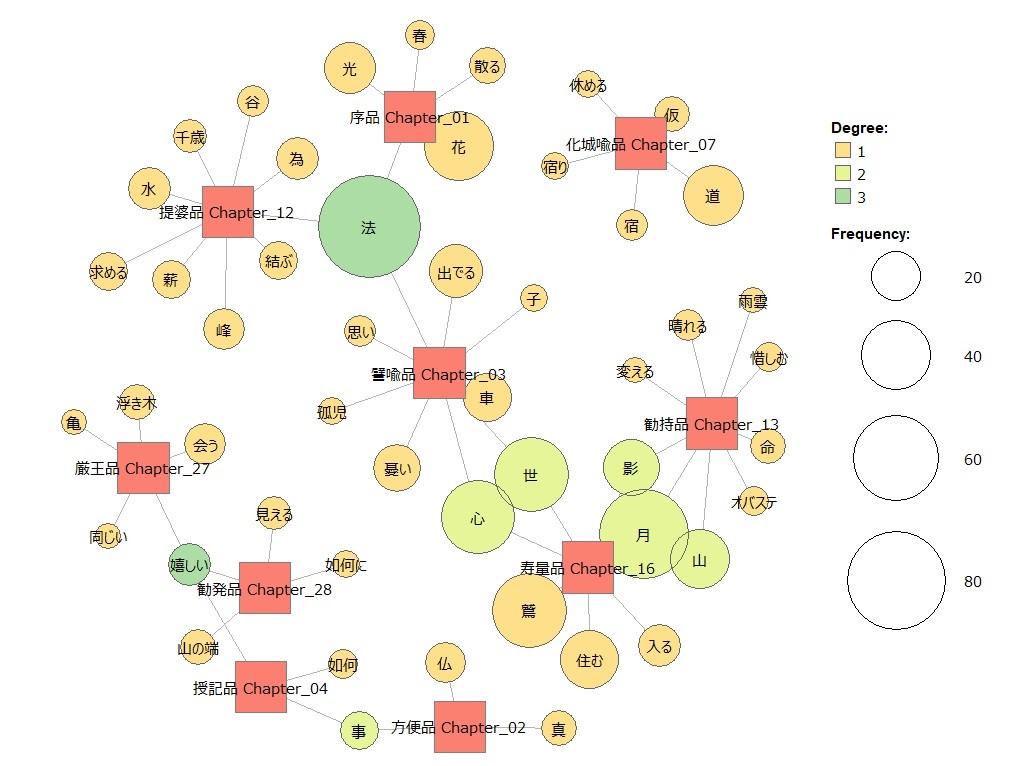1. Abstract
Re-interpreting the Paintings and Poems of the Lotus Sutra through a Co-occurrence Network: Religion and Life of the Aristocratic during the Japanese Medieval Ages
The Lotus Sutra has for long been regarded as the most popular scripture in the Tripitaka, which was followed by Japanese emperors and aristocrats from the eleventh to fourteenth centuries. (1). The most important version of the Lotus Sutra contains twenty-eight chapters in eight fascicles that were copied as eight or twenty-eight scrolls by the nobles at the time. According to one study (2), there exist approximately five hundred handscroll copies made between the eleventh and fourteenth centuries, which contain the frontispieces of the Lotus Sutra (Sanskrit-Saddharma Pundarika Sutra). Some of these frontispieces are depicted in gold and silver inks on indigo-dyed papers, while others are drawn by richly colored mineral paints on scattered gold or silver foils over papers. It is said that the latter were sometimes based on Waka poems of the Lotus Sutra, called Hokekyo-ka (Japanese-法華経歌).
The paper attempts to reveal that, for this research, motifs or symbols were extracted not from the Lotus Sutra but from the Waka poems based on it. This research also reveals that most of the extracted words could be correlated with the chapters of the Lotus Sutra, although there are common motifs in many of its chapters, such as Buddha, father, children, the moon, law, heart, and mountains. For example, Hana (花: flowers or cherry blossoms) relates to Chapter 1, Ushi (牛/憂し: cow or distressed) to Chapter 3, Mi (実/身: nut or body) to Chapter 12, Ama(尼/雨: nun or rain)to Chapter 13, Sumu(住む/澄む: live or clean)to Chapter 16, Uki(浮き/憂き: float or unhappy)to Chapter 27, and Yama-no-ha(山の端: ridgeline) to Chapter 28.
 Figure 1 : A Co-occurrence Network in the Hokekyo-ka
Figure 1 : A Co-occurrence Network in the Hokekyo-ka
Moreover, the paper points out that the above keywords are essentially based on the Lotus Sutra, and that some demonstrate paronomasia as pivot words (Japanese-掛詞). The number of pivot words extracted from the Lotus Sutra was larger than expected. This possibly indicates that the extracted words in Hokekyo-ka poetries developed not with the colored paintings on decorated papers, but rather with the Lotus Sutra paintings in gold and silver inks on indigo-dyed papers that were made under the Tang and Song dynasties in China.
Bibliography
(1) W. J. Tanabe, Paintings of the Lotus Sutra, John Weatherhill New York and Tokyo, 1988.
(2) Nara National Museum, Lotus Sutra -Its Calligraphy and Decotation-, Nara National Museum, 1987.
(3) http://khcoder.net/en/
(4) https://taku910.github.io/mecab/
(5) Toshinobu Ogiso, Mamoru Komachi, Yasuharu Den and Yuji Matsumoto. UniDic for Early Middle Japanese: a Dictionary for Morphological Analysis of Classical Japanese, In Proceedings of the 8th International Conference on Language Resources and Evaluation (LREC 2012), pp.911-915 (2012). https://unidic.ninjal.ac.jp/download_all#unidic_wabun
(6) Aiko Hashimura (Aida), The ideological and decorative program of Heike Nokyo: on the relationship between the images of the four seasons on the back of the "Jeweled Stupa" scroll and the pictorial schema for the twenty-eight chapters of the Lotus Sutra, Bijutsushi: a Journal of the Japan Art History Society (166), 2009-3. A. Hashimura, The Lotus Sutra in the Kagawa Museum: an extant example of Japanese painting in 12th century East Asia, The Kokka: a monthly journal of oriental art (1377), 2010-7.